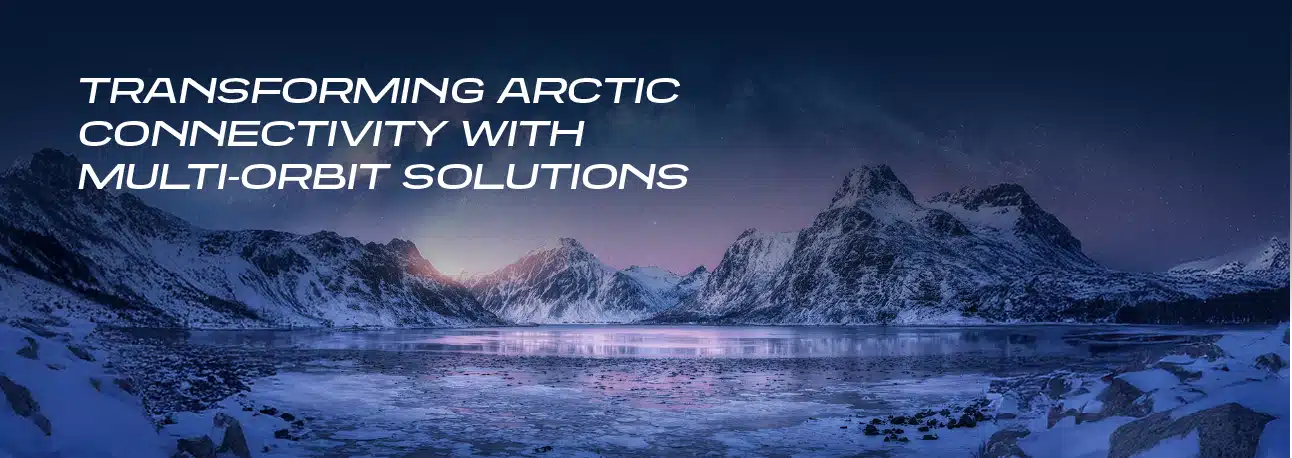The polar regions have traditionally represented some of the most isolated and challenging environments on Earth, testing the limits of satellite technology and the industries that rely on it. Today, changing climate conditions and shifting economic priorities are transforming these areas. As Arctic sea ice retreats, navigable routes remain open for longer portions of the year, creating opportunities for expanded commercial activity along with added considerations to protect the sensitive ecosystem. Cutting-edge advancements in satellite technology, especially in multi-orbit networks, are powering these changes, enabling safer, more efficient, and highly reliable operations in this demanding region.
Learn More About Our Single-Modem, Multi-Orbit Tracking
New Maritime Shipping Lanes Are Shorter, Faster, and More Sustainable
The growing accessibility of Arctic waters is driving a surge in shipping and offshore energy operations. As an example one key route, the North West Passage, can cut the distance between London and Tokyo, for example, to less than 8,000 miles (12,870 km) from the full 14,670-mile (23,600-km) route around Africa made necessary when the Suez Canal was shut down (1967–75 and more recently with the 2021 Ever Given blockage). The Northwest Passage also might permit the use of larger vessels than are permitted by the dimensions of Panama and Suez —despite improvements to both canals during the early 21st century.
Subject to access and rising temperatures the open periods of the Northeast and Northwest Passages are also extending, further fueling investments in Arctic oil, gas, and renewable energy projects.
Shorter Long-Haul Flights With Polar Routes
For airlines, polar routes also unlock shorter, more efficient paths between North America, Europe, and Asia. By using great circle routes – the shortest distance between two points on a globe – these paths cut fuel consumption, reduce costs, and lower emissions. This aligns perfectly with the aviation industry’s focus on reducing its environmental impact.
Additionally, advancements in satellite technology enhance navigation, real-time communication, and weather forecasting, making polar flights safer and more predictable. Leading carriers such as Emirates and Qatar Airways now rely on such routes to connect cities like Dubai and Doha to the U.S. West Coast and beyond, demonstrating the utility of these pathways near the North Pole.
Expanding Arctic Coverage with Non-Geosynchronous Orbits (NGSO) enabling Constant Connectivity
Until recently, aircraft traversing polar regions struggled with significant connectivity challenges, including prolonged coverage gaps of up to an hour during high-latitude flights. These limitations have been addressed by recent advancements in satellite networks, delivering seamless high-latitude connectivity through innovative satellite constellations and advanced ground systems.
Historically, traditional Geosynchronous Earth Orbit (GEO) satellites, orbiting along the Equatorial plane, have left the polar regions underserved. However, Non-Geosynchronous Orbit (NGSO) constellations, such as Highly Elliptical Orbits (HEO), are specifically engineered to fill this gap. By following elongated, dynamic paths over the poles, HEO satellites provide robust and uninterrupted Arctic coverage, enhancing safety for passengers and crew alike.
Valour Consultancy’s report, The Future of Maritime Connectivity – 2024, highlights how NGSO constellations are overcoming these coverage challenges, delivering reliable connectivity to regions once thought unreachable.
Regional Leadership and Strategic Action
For the Norwegian Armed Forces, ensuring broadband connectivity in the Arctic remains a national priority. Space Norway, Northern Europe’s leading satellite operator, is leading this effort with its Arctic Satellite Broadband Mission (ASBM), which launched two satellites into HEO to meet national and defence goals.
These satellites, ASBM 1 and ASBM 2, host payloads for the Norwegian Armed Forces, U.S. Space Force and are carrying commercial service payloads for Viasat.
Leveraging Multi-Orbit Coverage for Unique Arctic Needs
Navigating between polar and lower-latitude regions requires the seamless integration of multiple satellite orbits. Multi-orbit solutions, combining capabilities from GEO and HEO satellites, ensure continuous and reliable coverage for vessels and aircraft transitioning between latitudes.
Viasat uses ST Engineering iDirect’s state-of-the-art multi-orbit technology for its high-speed GX network for Governments. The technology enables intelligent switching between GEO and HEO satellites and ensures uninterrupted service as systems optimize for orbit-specific frequency, timing, and motion patterns. Following successful in-orbit testing, Viasat reported that government services are now available through the GX10 HEO payloads, with commercial maritime and aviation capabilities anticipated to begin throughout the company’s FY26 fiscal year.
This advanced multi-orbit tracking and switching technology is already available to customers on iDirect’s Velocity® platform, currently utilized by Viasat. It is also a feature of the newly launched Intuition ground system.
The Future of Arctic Satellite Communications
The satellite industry is revolutionizing Arctic connectivity, addressing critical needs across aviation, maritime, and defence sectors. With Space Norway’s pioneering ASBM and innovations like Viasat’s and ST Engineering iDirect’s multi-orbit solutions, satellite communications are enabling safer, more efficient operations in these remote regions.
Beyond safety and reliability considerations, these advancements unlock significant potential in Arctic regions. Businesses and governments can work with confidence, knowing that robust satellite-backed solutions support even the most challenging environments.
At ST Engineering iDirect, we’re dedicated to pushing the boundaries of satellite technology. By expanding what’s possible in global connectivity, we empower our partners and customers to operate in the toughest regions, in an increasingly connected world.
